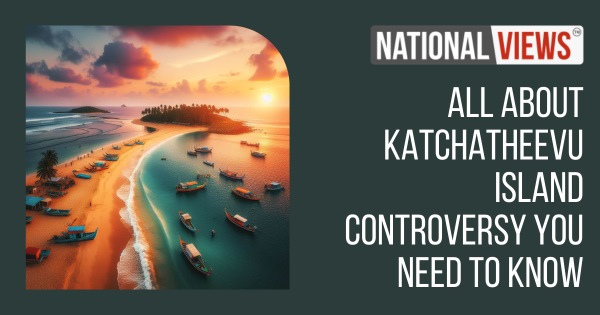The Katchatheevu Island controversy is a long-standing issue between India and Sri Lanka, revolving around fishing rights and sovereignty over the uninhabited island. Here is a comprehensive overview of the Katchatheevu Island controversy:
Historical Background:
Katchatheevu is a 285-acre uninhabited island located in the Palk Strait between India and Sri Lanka. It’s quite small, only around 1.6 kilometers long and a bit over 300 meters wide at its widest point. Situated only about 33 kilometers northeast of Rameswaram, India, and approximately 62 kilometers southwest of Jaffna, Sri Lanka, Katchatheevu is also about 24 kilometers from the inhabited Delft Island, which is part of Sri Lanka. (Reference)
It was jointly administered by India and Sri Lanka during British rule. The island’s ownership was historically claimed by both countries, with control passing from the Jaffna kingdom of Sri Lanka to the Ramnad zamindari based in Ramanathapuram (about 55 kilometers northwest of Rameswaram) during the 17th century.
During British rule, Katchatheevu became part of the Madras Presidency. However, there was a disagreement between India and Sri Lanka about who owned the island. Both countries wanted to decide on fishing boundaries. In 1921, a survey marked Katchatheevu as part of Sri Lanka. But people from India, representing the old Ramnad kingdom, said it belonged to them. This argument dragged on until 1974 when it was finally settled.
After India’s independence, the unresolved territorial dispute between Ceylon (now Sri Lanka) and the British led to negotiations to settle the ownership of Katchatheevu. In 1974, Prime Ministers Indira Gandhi of India and Sirima R.D. Bandaranaike of Sri Lanka signed an agreement recognizing Katchatheevu as part of Sri Lanka’s territory.
What Was the 1974 Agreement?
In 1974, then-Prime Minister Indira Gandhi tried to settle the border between India and Sri Lanka once and for all. As part of this agreement, called the ‘Indo-Sri Lankan Maritime Agreement’, she agreed to give Katchatheevu to Sri Lanka. She believed the island wasn’t very strategically important, and she thought it would strengthen ties with Sri Lanka. According to the agreement, Indian fishermen could still go to Katchatheevu like before.
But unfortunately, the agreement didn’t sort out fishing rights. Sri Lanka understood that Indian fishermen could only go to Katchatheevu for things like resting, drying nets, and visiting the Catholic shrine, without needing a visa. Then, in 1976, during the Emergency in India, another agreement was made. This agreement said that neither country could fish in the other’s Exclusive Economic Zone. Since Katchatheevu is right on the edge of both countries’ zones, it made fishing rights even more uncertain.
Fishing Rights and Livelihood:
Fisherfolk from both India and Sri Lanka historically used Katchatheevu for fishing. This agreement allowed Indian fishermen to fish around the island, dry their nets on it, and permitted Indian pilgrims to visit the Catholic shrine located on the island.
The 1974 agreement acknowledged this practice, but a supplemental pact in 1976 imposed restrictions on fishing vessels and fishermen from either nation, prohibiting fishing in each other’s waters without explicit permission. (Source)
Political and Public Sentiment:
The transfer of Katchatheevu triggered opposition and debates in both Indian Houses of Parliament. Leaders of Tamil Nadu have periodically raised the demand for the island’s retrieval, with suggestions of a “lease in perpetuity” for the island.
Indian Government Stance and Legal Aspects:
In 1991, following India’s intervention in the Sri Lankan Civil War, the Tamil Nadu Assembly demanded the retrieval of Katchatheevu and the restoration of fishing rights. Since then, it has been a recurring issue in Tamil politics.
In 2008, Jayalalitha of the AIADMK (an Indian regional political party alliance in the state of Tamil Nadu and the union territory of Puducherry) filed a petition, arguing that Katchatheevu couldn’t be ceded without a constitutional amendment, affecting fishermen’s livelihoods. Upon becoming chief minister in 2011, Jayalalitha moved a resolution in the State Assembly and petitioned the Supreme Court to expedite the matter due to increased arrests of Indian fishermen by Sri Lanka.
Last year, Tamil Nadu’s Chief Minister MK Stalin wrote to PM Modi, urging discussions on Katchatheevu during Sri Lankan Prime Minister’s visit, citing the deprivation of fishermen’s rights. The Union government maintains that no Indian territory was ceded, but Tamil politicians continue to demand the island’s retrieval.
Despite calls from Tamil Nadu and the BJP’s demand for retrieval, little action has been taken, as it would require going to war to reclaim Katchatheevu, as per the Attorney General’s statement to the Supreme Court in 2014. The Indian government stated in 2013 that no Indian territory was ceded as Katchatheevu lies on the Sri Lankan side of the India-Sri Lanka International Maritime Boundary Line. The issue was framed as a dispute between British India and Ceylon (now Sri Lanka), resolved through agreements in 1974 and 1976.
Katchatheevu Island Controversy : Recent Developments
Prime Minister Narendra Modi reignited the Katchatheevu controversy, accusing the Congress of giving away the island to Sri Lanka in 1974. This issue has resurfaced during election seasons, sparking debates and discussions on the historical, legal, and political aspects of the island’s transfer.
The Katchatheevu Island controversy remains a sensitive and unresolved issue, impacting fishing communities, political relations, and public sentiment between India and Sri Lanka. Despite consistent appeals from Tamil Nadu, the Indian government’s stance on Katchatheevu has remained unchanged.
Also Read: Indian History: How Samrat Ashoka Become a King?


